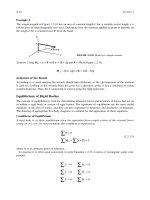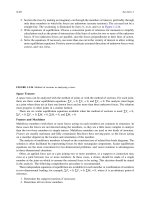CRC Press - Mechanical Engineering Handbook- Mechanics Of Solids Part 5 ppsx
Bạn đang xem bản rút gọn của tài liệu. Xem và tải ngay bản đầy đủ của tài liệu tại đây (30.2 KB, 1 trang )
1-40 Section 1
(1.3.25a)
Time Rate of Change of Angular Momentum
In general, a force acting on a particle changes its angular momentum: the time rate of change of angular
momentum of a particle is equal to the sum of the moments of the forces acting on the particle.
A special case is when the sum of the moments about point O is zero. This is the conservation of
angular momentum. In this case (motion under a central force), if the distance r increases, the velocity
must decrease, and vice versa.
Impulse and Momentum
Impulse and momentum are important in considering the motion of particles in impact. The linear
impulse and momentum equation is
(1.3.28)
Conservation of Total Momentum of Particles
Conservation of total momentum occurs when the initial momentum of n particles is equal to the final
momentum of those same n particles,
(1.3.29)
When considering the response of two deformable bodies to direct central impact, the coefficient of
restitution is used. This coefficient e relates the initial velocities of the particles to the final velocities,
(1.3.30)
Hijk
Ox y z
xzy
yxz
zyx
HHH
H m yv zv
H m zv xv
H m xv yv
=++
=−
()
=−
()
=−
()
Vectors:
˙
( )HrvrFH
OO
d
dt
m=×
()
=× =
∑∑
1326
Scalars: MH MH MH
xx yy zz
∑∑∑
===
˙˙˙
MHrv
OO
m==×=
()
∑
0
1327
constant
conservation of angular momentum ( . . )
t
t
dt m m
1
2
21
∫
=−
impulse
final
momentum
initial
momentum
{
{
{
Fvv
mm
ii
i
n
t
ii
i
n
t
vv
()
=
()
∑∑
12
12
total initial
momentum at time
total final
momentum at time
1243412434
e
vv
vv
Bf Af
AB
=
−
−
=
relative velocity of separation
relative velocity of approach









